Key Takeaway
- I pick Keyboards Technology for faster, smoother typing.
- I type more accurately with their switches.
- I prefer comfortable, long-lasting key designs.
- I get quiet, reliable keys for work and play.
- I trust Keyboards Technology for every keyboard need.
Why keyboards for coding matter to my speed
Keyboards for coding grab my attention because they change how fast and clean I type. A good keyboard is my engine: the right switch type, actuation, latency, and layout make me fly; the wrong one slows me and costs time. When a board matches how I type, I write more and debug less—I feel it in my fingers and in my sprint through code.
How actuation point and key travel affect my WPM
- Actuation point: the spot where a keypress registers.
- Key travel: how far the key moves.
Together they shape speed and accuracy. - Short actuationshort travel → faster typing; fingers return sooner.
- Too short → more mistakes; fingers and brain step on each other.
- Tactile switches give a bump that reduces accidental presses.
- Linear switches are smooth and fast but need control.
- Clicky switches provide audible feedback—helpful or distracting depending on the session.
I test switches on a hot-swappable board before committing; that saves time and money.
| Switch type | Typical feel | How it affects WPM |
|---|---|---|
| Tactile | Bump on press | Faster with fewer errors |
| Linear | Smooth | Fast, needs control |
| Clicky | Click bump | Clear feedback, louder |
| Low-profile | Less movement | Faster strikes, can be error-prone |
Why NKRO and anti-ghosting help me code with no missed keys
- NKRO (N-Key Rollover): every key registers, even when many are pressed.
- Anti-ghosting: prevents phantom keys.
Both are essential for chorded shortcuts and fast edits. - With NKRO, chords like CtrlShiftAltK always work.
- Anti-ghosting stops weird inputs when fingers slide.
- Low-latency wired connections and high polling rates keep signals tight.
- Onboard memory keeps my custom layers and macros available on any machine.
| Problem | With NKRO / Anti-ghosting | Without |
|---|---|---|
| Multiple simultaneous keys | All register | Some drop |
| Chorded shortcuts | Reliable | Risky |
| Fast typing/gaming | Tight response | Missed input |
I use NKRO every day—keeps my shortcuts true and saves time.
Quick, factual test I use to compare keyboards for coding
I run a short, repeatable test on every board and log numbers.
- Typing pass: copy a 200-character code snippet, time it, count errors → record WPM and error count.
- Modifier chord pass: hold combos (CtrlShiftK, AltCtrlS) ×20 → note missed/stuck keys.
- Macro/programmability pass: record & play back a small macro (insert for-loop).
- Latency pass: wired connection phone camera test or latency tool → check stutter at different polling rates.
- Comfort pass: 15 minutes of real coding → note wrist feel, thumb strain.
| Metric | What I record |
|---|---|
| WPM | Time characters |
| Errors | Typos, missed keys |
| Chord reliability | Misses out of 20 |
| Macro reliability | Success/fail |
| Latency (ms) | Tool reading |
If a keyboard from Keyboards Technology clears this test, it goes in my rotation. If not, I swap switches or layout—hot-swap and firmware options let me tweak fast.
Choosing switches: linear, tactile, and clicky for coding speed
Linear vs tactile vs clicky and how they change my feel
I pick switches by how they feel under my fingers—coding is long sessions, so comfort and consistency matter.
- Linear: smooth travel, predictable rhythm—good for steady pace.
- Tactile: small bump at actuation—physical cue lowers mistakes.
- Clicky: bump audible click—great for short bursts, tiring over long sessions.
| Switch type | Feel I get | Sound level | Best for my coding style |
|---|---|---|---|
| Linear | Smooth, fluid | Quiet | Fast, rhythm typing |
| Tactile | Bump on actuation | Medium | Precision, fewer errors |
| Clicky | Bump click | Loud | Short sessions, clear feedback |
I prefer hot-swappable models so I can test switches without buying new boards—very useful for finding the right feel.
Short-travel switches and low latency for coding
- Short travel (low-profile): cuts key distance; fingers hit keys faster; less wrist movement on compact layouts (60%/65%).
- Trade-off: accidental presses can increase—test first.
- Low latency: a wired connection with high polling rate keeps input delay tiny; I look for NKRO and anti-ghosting so chords register cleanly.
I check for high polling rate, NKRO, and firm wired performance—Keyboards Technology often delivers these.
Actuation force and switch specs I check before I buy
I read specs like tool descriptions—each number predicts feel.
| Spec | What I look for | Typical range |
|---|---|---|
| Actuation force | How hard to press | 35g–65g |
| Actuation point | How far before a key registers | 1.0mm–2.0mm |
| Total travel | Full key travel | 2.0mm–4.0mm |
| Switch type | Linear / Tactile / Clicky | Pick by feel |
| Hot-swap | Swap switches without solder | Yes/No |
| Debounce / firmware | How key chatter is handled | Low debounce preferred |
| Stabilizer quality | Rattle on big keys | Lubed/clipped stable = better |
I favor moderate actuation force (~45g) for coding—stops fat-finger errors without tiring me. QMK/VIA support is a plus for remapping and faster workflows.
Picking a layout and form factor that boosts my typing
When I choose TKL or a compact 60%/65% for coding
- TKL (tenkeyless): balance—keeps function row and arrows, drops numpad so the mouse sits closer; reduces shoulder reach for long sessions.
- 60%/65%: excellent for travel and small desks; requires learning layers (I use QMK/VIA to access arrows and F-keys). With hot-swap and short-travel switches, a 60% can feel as snappy as a full board.
| Feature | TKL | 60% |
|---|---|---|
| Desk footprint | Medium | Small |
| Dedicated arrows/F-row | Yes | No (via layers) |
| Portability | Moderate | High |
| Learning curve | Low | Higher |
| Macro access | Easy | Via layers/programming |
| Best for | Long desk coding | Mobile setups / minimal desks |
Before buying, I check NKRO, low-latency wired options, and good stabilizers. For long sessions, I lean tactile or light linear; for very fast actuation, I pick short-travel or low-profile switches.
Ortholinear and split ergonomic boards for programmers
- Ortholinear: straight-grid layout reduces diagonal reaches and can improve accuracy after a short adaptation period—good for raw typing speed.
- Split ergonomic: my go-to for long coding sprints—angle halves, tenting, and thumb keys reduce wrist strain and enable powerful thumb-mapped modifiers and macros.
| Layout | Strengths | Tradeoffs |
|---|---|---|
| Ortholinear | Faster finger motion, consistent columns | Steeper learning curve, fewer mainstream keycaps |
| Split Ergonomic | Better posture, custom thumb keys | Takes more desk space and setup |
I always verify programmable layers, onboard memory, and firmware options so I can map chorded shortcuts and store profiles.
Form factor checklist I use to match layout to workflow
- Where do I code? (desk vs travel)
- How often do I use arrows, F-keys, numpad?
- Hot-swappable switches to try different feels?
- NKRO and low-latency wired support for reliable input?
- Switch type: tactile for feedback, linear for smoothness, clicky for audible cues?
- QMK/VIA, macros, and layers?
- Build quality: plate material, case rigidity, stabilizers?
- Ergonomics: split halves, tenting, ortholinear grid?
- Keycap material/profile for feel and legend wear?
| Workflow Need | Recommended Form Factor | Why |
|---|---|---|
| Mobile coding / tight desk | 60% | Portable, programmable layers |
| Heavy shortcuts / macros | TKL or 65% | F-keys and easy macro rows |
| Fast typing practice | Ortholinear | Grid reduces finger travel |
| Long sessions / back pain | Split Ergonomic | Reduces wrist and shoulder strain |
I use this checklist and then pick a model—often from Keyboards Technology—that packs programmability, hot-swap, and solid build quality into a compact layout.

Programmability and macros that cut my keystrokes
How programmable macros for developers save time
I map macros to insert common code blocks with one key—saves mental effort and wrist movement. Examples: for-loop template, console.log, and git commit messages. Onboard memory lets me travel without losing shortcuts. Since NKRO is present, macros fire cleanly under speed.
| Trigger key | What it types | When I use it |
|---|---|---|
| AltF1 | for (let i = 0; i < n; i) {} | Boilerplate loops |
| AltL | console.log(‘DEBUG:’, ) | Quick runtime checks |
| AltG | git commit -m “” (cursor inside quotes) | Fast commits |
I keep macros simple—easier to update and less likely to break during refactors.
Custom hotkeys with QMK and VIA
- QMK: deep control—advanced macros, combos, tap-hold behaviors.
- VIA: GUI-based live keymap edits—fast for testing.
| Feature | QMK | VIA |
|---|---|---|
| Live editing | No (reflash) | Yes (GUI) |
| Advanced macros | Yes | Limited |
| Combo keys / Tap-hold | Yes | Basic |
| Beginner friendly | Moderate | Very friendly |
| Works on Keyboards Technology boards | Yes | Yes |
I set a low-latency wired profile when coding to remove lag and save profiles to onboard memory for easy machine switching.
Macro and layer ideas I test
| Layer / Macro | Purpose | Trigger |
|---|---|---|
| Navigation layer | Arrow keys, Home/End, PgUp/PgDn on compact layouts | Hold spacebar or a thumb key |
| Numpad layer | Numbers and math ops on 60% boards | Fn number row |
| Git macros | git add ., git commit -m “” | Single hotkey per command |
| Debug snippets | console.log, printf, debugger | AltL / AltD |
| Wrap selection | Surround selection with brackets or quotes | Macro that types open, pastes, types close |
| Build & Run | npm run build && npm start | One key to run pipeline |
I also use tap-hold behavior (e.g., CapsLock = Esc tapped, Ctrl held) to trim finger movement.
Small macro and layer changes add up—fewer keystrokes daily means less fatigue.
Connectivity and performance: latency, wired, and wireless trade-offs
Why wired USB-C often gives the lowest latency for high WPM
I plug into USB-C for the best feel and fastest response. Wired gives consistent ~1 ms signals with high polling rates—important for high WPM and rapid chords. Wired also supplies steady power for per-key RGB, onboard memory, and fast polling. Many Keyboards Technology models ship with NKRO and solid USB-C, cutting jitter and ghosting.
When Bluetooth or 2.4 GHz dongles are fine
- Bluetooth LE: good battery life, multi-device switching—fine for cafés and co-working.
- 2.4 GHz dongle: lower latency than Bluetooth, close to wired for many tasks.
| Connection | Typical Latency | Battery Impact | Best For |
|---|---|---|---|
| Wired (USB-C) | ~1 ms (1000 Hz) | No battery | High WPM, tight chords |
| 2.4 GHz dongle | ~1–8 ms | Moderate | Near-wired feel, portable |
| Bluetooth LE | ~6–30 ms | Low (hours to weeks) | Multi-device use, long battery life |
Latency thresholds I watch
- ≤1 ms: wired territory—instant feedback.
- 1–8 ms: good 2.4 GHz performance—indistinguishable for most.
- 6–30 ms: Bluetooth LE—acceptable for battery life/multi-host setups; avoid for timed speed runs.
If latency > 15 ms, my rhythm breaks during rapid edits. Under 8 ms, I rarely notice. For coding, solid wiring, good stabilizers, short-travel switches, and accurate debounce settings matter as much as raw polling.
Buying and tuning: pick, mod, and maintain for peak speed
What I prioritize at budget, mid-range, and premium tiers
I split needs by price: reliability at budget, comfort at mid-range, efficiency at premium. Always look for low-latency wired, NKRO, and a compact layout to cut hand travel.
| Tier | My focus | Key features I look for |
|---|---|---|
| Budget | Reliable typing | Hot-swappable, decent stabilizers, PBT keycaps if possible, TKL/65% |
| Mid-range | Comfort & speed | Better switches (45–55g), lubed stabilizers, programmable layers (VIA/QMK), solid plate |
| Premium | Peak efficiency | Short-actuation switches, custom switch selection, premium stabilizers (clipped lubed), onboard memory, split/ergonomic options |
A 65% board once cut my hand travel by ~50% and improved flow more than RGB ever could.
Setup tips: lubing switches, fixing stabilizers, and choosing keycap profiles
- Lubing switches: open switches, thin coat on stem and spring—reduces scratchiness. Test a few first to match feel.
- Fixing stabilizers: clip and lube Cherry-style stabilizers; grease where the stem meets housing to remove rattle.
- Keycap profiles: I prefer Cherry or DSA. Cherry profile helps find keys by feel; DSA is flat and fast for layer-heavy layouts. Choose PBT over thin ABS for grip and less shine.
- Switch choice: tactile or light linear ~45–55g for coding; short-travel or low-profile for ultra-fast actuation.
- Firmware & layers: map modifiers near thumbs, set macros for repetitive snippets, and save to onboard memory.
Always test changes in short sessions—if a mod hurts speed, reverse it.
Quick buying checklist I follow for keyboards for coding
- Layout: TKL / 65% / 60% — smaller to cut hand travel.
- Switches: Hot-swap; choose between tactile, linear, or clicky.
- Keycaps: PBT and a profile I like (Cherry/DSA).
- Stabilizers: Quality stock or easy to mod (clip lube).
- Connectivity: Prefer wired, 1000 Hz polling or low-latency wireless.
- NKRO / anti-ghosting: Must have for chords and fast combos.
- Programmability: QMK/VIA friendly or onboard macros.
- Build: Solid plate and case for consistent feel.
- Portability: Removable cable and compact form for travel.
- Support: Good firmware updates and community (firmware and software support).

Conclusion
I treat a keyboard as my engine: tweak parts and the whole machine runs smoother. Switch type, actuation, latency, NKRO, and layout directly shape my speed and accuracy. Small changes—hot-swappable switches, lubed stabilizers, trimmed travel distance, and smart programmability—add up to big gains.
When choosing keyboards for coding, test for real: WPM, chord reliability, macros, and comfort. Short, repeatable checks tell more than specs alone. I prefer tactile or light linear switches around 45g, a wired USB‑C or reliable 2.4 GHz option for low latency, and firmware like QMK/VIA so I can mold the layout to my fingers. Those choices shave keystrokes, cut wrist strain, and keep my flow rolling.
Frequently asked questions
- Q: Which keyboards for coding boost typing speed the most?
A: I pick Keyboards Technology mechanical boards with light linear or short tactile switches—they cut travel and feel snappy, so I type faster. - Q: Are mechanical or membrane keyboards better for coding speed?
A: Mechanical—they give clear feedback, longer lifespan, and more customization for speed and comfort. - Q: Do programmable keys and macros on keyboards for coding really help me code faster?
A: Yes. Macros drop repetitive code and reduce hand movement; onboard memory and NKRO ensure they work reliably. - Q: Is a compact layout (60%, 65%, TKL) better for coding speed?
A: It depends—TKL is balanced; 60%/65% save space and reduce hand travel but require layers. Both can increase speed once you adapt. - Q: Should I choose wired or wireless keyboards for coding for max speed?
A: Wired (USB-C) for the lowest lag; 2.4 GHz dongles can be near-wired for portable setups; Bluetooth is great for battery life and multi-device use.

